
The officially stated goals of the foreign policy of the United States of America, including all the bureaus and offices in the United States Department of State, as mentioned in the Foreign Policy Agenda of the Department of State, are "to build and sustain a more democratic, secure, and prosperous world for the benefit of the American people and the international community". Liberalism has been a key component of US foreign policy since its independence from Britain. Since the end of World War II, the United States has had a grand strategy which has been characterized as being oriented around primacy, "deep engagement", and/or liberal hegemony. This strategy entails that the United States maintains military predominance; builds and maintains an extensive network of allies ; integrates other states into US-designed international institutions ; and limits the spread of nuclear weapons.
The United States Armed Forces are the military forces of the United States. The armed forces consist of six service branches: the Army, Marine Corps, Navy, Air Force, Space Force, and Coast Guard. All six armed services are among the eight uniformed services of the United States.

The United States invaded Panama in mid-December 1989 during the presidency of George H. W. Bush. The primary purpose of the invasion was to depose the de facto ruler of Panama, General Manuel Noriega, who was wanted by U.S. authorities for racketeering and drug trafficking. The operation, codenamed Operation Just Cause, concluded in late January 1990 with the surrender of Noriega. The Panama Defense Forces (PDF) were dissolved, and President-elect Guillermo Endara was sworn into office.

The Global War on Terrorism Service Medal (GWOT-SM) is a military award of the United States Armed Forces which was created through Executive Order 13289 on 12 March 2003, by President George W. Bush. The medal recognizes those military service members who have supported operations to counter terrorism in the War on Terror from 11 September 2001, to a date yet to be determined.
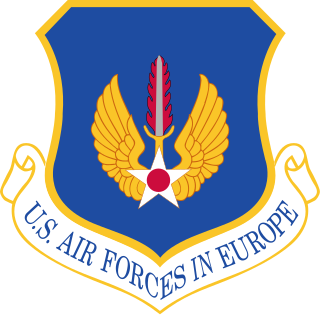
The United States Air Forces in Europe – Air Forces Africa (USAFE-AFAFRICA) is a United States Air Force (USAF) major command (MAJCOM) and a component command of both United States European Command (USEUCOM) and United States Africa Command (USAFRICOM). As part of its mission, USAFE-AFAFRICA commands U.S. Air Force units pledged to NATO, maintaining combat-ready wings based from the United Kingdom to Turkey. USAFE-AFAFRICA plans, conducts, controls, coordinates and supports air and space operations in Europe, parts of Asia and all of Africa with the exception of Egypt to achieve U.S. national and NATO objectives based on taskings by the two combatant commanders.

Military advisors or combat advisors are military personnel deployed to advise on military matters. The term is often used for soldiers sent to foreign countries to aid such countries' militaries with their military education and training, organization, and other various military tasks. The foreign powers or organizations may send such soldiers to support countries or insurgencies while minimizing the risks of potential casualties and avoiding the political ramifications of overtly mobilizing military forces to aid an ally.

Aviano Air Base is a base in northeastern Italy, in the Friuli-Venezia Giulia region. It is located in the Aviano municipality, at the foot of the Carnic Pre-Alps or Southern Carnic Alps, about 15 kilometres (9.3 mi) from Pordenone.

The United States Air Force Security Forces (SF) are the ground combat force and military police service of the U.S. Air Force and U.S. Space Force. The USAF Security Forces were formerly known as Military Police (MP), Air Police (AP), and Security Police (SP) at various points in their history. Due to its significant ground combat mission, Security Forces are sometimes regarded as Air Force infantry within the Air Force and were formed on the premise of being the Air Force's "Marine Corps", in that they would provide security for the Air Force similar to how the Marines provide security for the Navy.
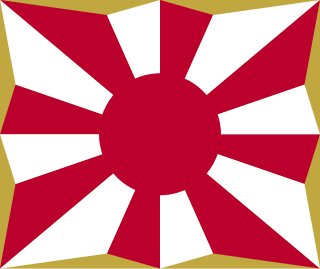
The Japan Self-Defense Forces, also known as the Japanese Armed Forces, are the unified de facto military forces of Japan. Established in 1954, the JSDF comprises the Japan Ground Self-Defense Force, the Japan Maritime Self-Defense Force, and the Japan Air Self-Defense Force. They are controlled by the Ministry of Defense with the Prime Minister as commander-in-chief.

U.S. Coast Guard Port Security Units are Deployable Specialized Forces organized for sustained expeditionary security and anti-terrorism. They provide Anti-Terrorism Force Protection (ATFP) missions, which include harbor and port defense, protection of High Value Assets (HVAs), expeditionary security, Sea Lines of Communications (SLOCs), special missions. and coastal surveillance. PSUs are expeditionary units that conduct OCONUS missions in support of a requesting regional combatant commander. PSUs usually operate under the direction of the Coast Guard's Pacific Area (PACAREA) command but are unique in that they are the only Coast Guard units that can be quickly requested by the Department of Defense.

Naval Air Station Keflavik (NASKEF) is a United States Navy air station at Keflavík International Airport, Iceland, located on the Reykjanes peninsula on the south-west portion of the island. NASKEF was closed on 8 September 2006, and its facilities were taken over by the Icelandic Defence Agency as their primary base until 1 January 2011, when the Agency was abolished and the base handed over to the Icelandic Coast Guard, which has operated the base until 2017. US forces returned to Keflavik in 2016, renovating parts of the base to accommodate P-8As on short duration/expeditionary detachments.
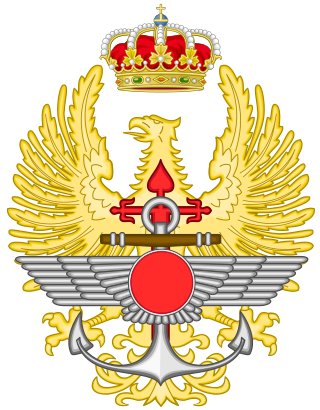
The Spanish Armed Forces are in charge of guaranteeing the sovereignty and independence of the Kingdom of Spain, defending its territorial integrity and the constitutional order, according to the functions entrusted to them by the Constitution of 1978. They are composed of: the Army, the Air and Space Force, the Navy, the Royal Guard, and the Military Emergencies Unit, as well as the so-called Common Corps.
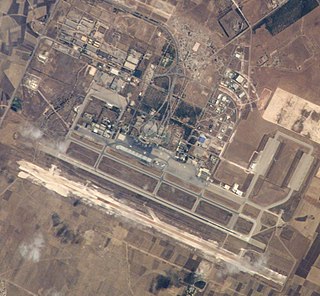
Nouasseur Air Base near Casablanca in Morocco, was a United States Air Force base from 1951 to 1963. It was designed for B-36 and B-47 bombers but never came into use, and also housed repair units for a period. Today, Nouasseur AB is known as Mohammed V International Airport. It hosts helicopters of the Royal Moroccan Navy.

The United States Africa Command is one of the eleven unified combatant commands of the United States Department of Defense, headquartered at Kelley Barracks, Stuttgart, Germany. It is responsible for U.S. military operations, including fighting regional conflicts and maintaining military relations with 53 African nations. Its area of responsibility covers all of Africa except Egypt, which is within the area of responsibility of the United States Central Command. U.S. AFRICOM headquarters operating budget was $276 million in fiscal year 2012.
The United States Air Force became a separate military service on 18 September 1947 with the implementation of the National Security Act of 1947. The Act created the National Military Establishment, later renamed the United States Department of Defense, which was composed of four of the five branches, the Army, Marine Corps, Navy, and a newly created Air Force. Prior to 1947, the responsibility for military aviation was divided between the Army for land-based operations and the Navy and Marine Corps for sea-based operations from aircraft carrier and amphibious aircraft. The Army created the first antecedent of the Air Force on 1 August 1907, which through a succession of changes of organization, titles, and missions advanced toward eventual separation 40 years later. The predecessor organizations leading up to today's U.S. Air Force are:
The structure of the United States Navy consists of four main bodies: the Office of the Secretary of the Navy, the Office of the Chief of Naval Operations, the operating forces, and the Shore Establishment.

The Wyoming Air National Guard (WY ANG) is the aerial militia of the State of Wyoming, United States of America. It is, along with the Wyoming Army National Guard, an element of the Wyoming National Guard.

Homestead Air Reserve Base, previously known as Homestead Air Force Base is located in Miami–Dade County, Florida to the northeast of the city of Homestead. It is home to the 482nd Fighter Wing of the Air Force Reserve Command's Tenth Air Force, as well as the headquarters of Special Operations Command South.
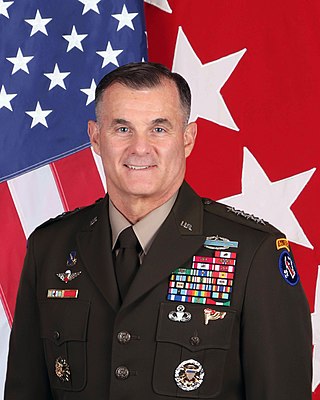
Charles A. Flynn is a United States Army general who serves as commanding general of United States Army Pacific since 4 June 2021. He previously served as Deputy Chief of Staff for Operations, Plans and Training (G3/5/7) of the Army Staff from June 2019 to May 2021. He is the younger brother of Lieutenant General Michael T. Flynn, Donald Trump's first National Security Advisor.

Throughout its history and up to the present day, the United States has had close ties with authoritarian governments. During the Cold War, the U.S. backed anti-communist governments that were authoritarian, and were often unable or unwilling to promote modernization. U.S. officials have been accused of collaborating with oppressive and anti-democratic governments to secure their military bases in Central America, Africa, Asia, and the Middle East. The Economist Democracy Index classifies many of the forty-five currently non-democratic U.S. military base host countries as "authoritarian governments".

















